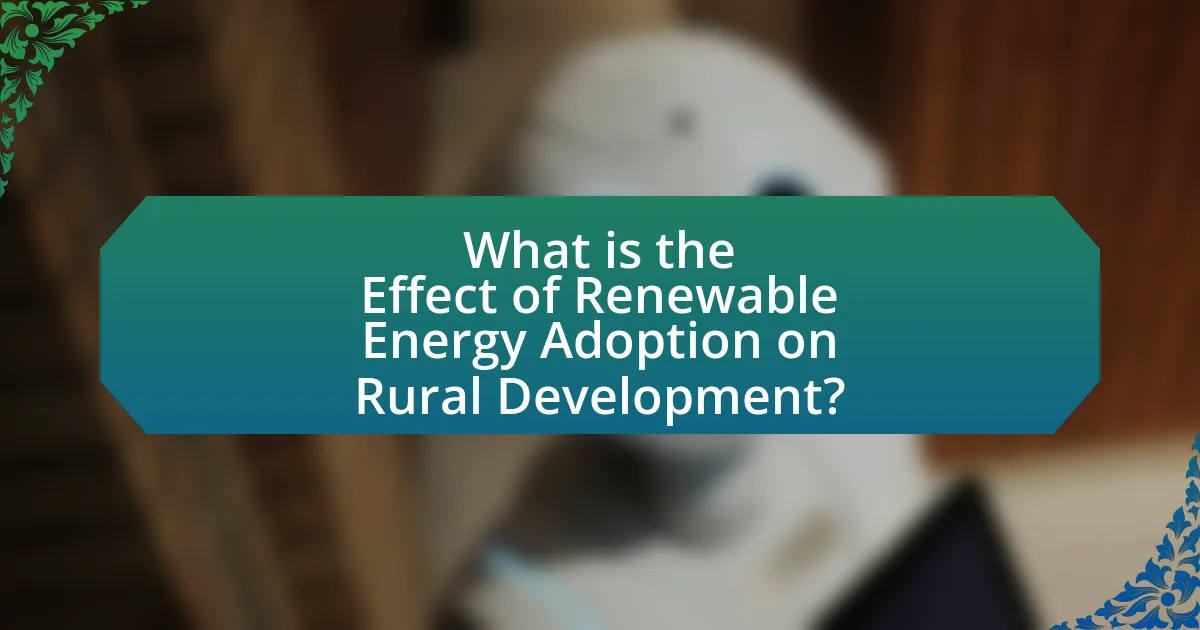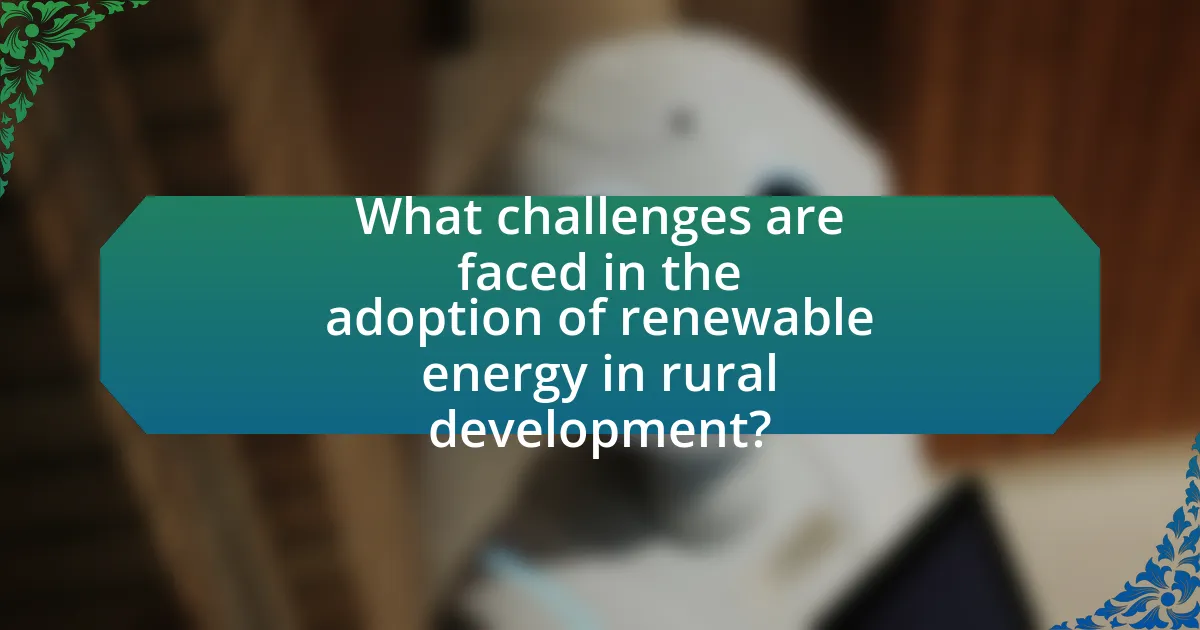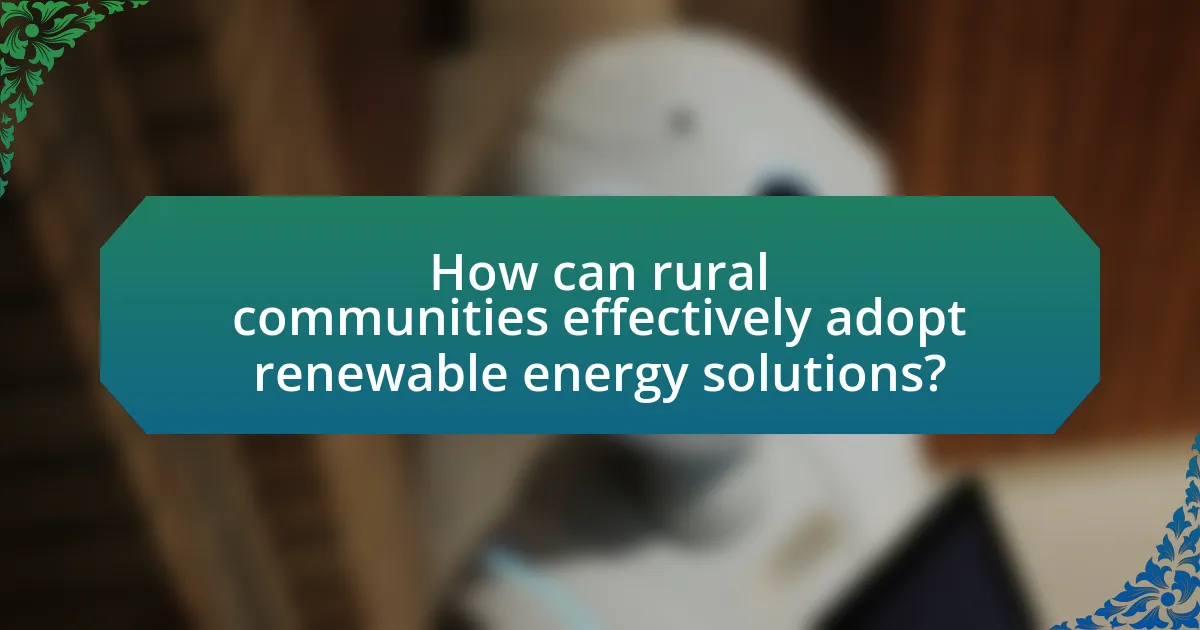The article examines the positive effects of renewable energy adoption on rural development, highlighting its role in enhancing economic growth, improving energy access, and creating jobs. It discusses how renewable energy projects, such as solar and wind, lead to increased local investment and infrastructure development, while also reducing reliance on imported fuels. Key benefits include job creation, improved quality of life, and community empowerment, alongside environmental advantages like reduced greenhouse gas emissions. The article also addresses challenges faced in implementing renewable energy solutions, including financial barriers, technical expertise, and regulatory hurdles, while providing insights into best practices and resources available for rural communities to effectively adopt renewable energy initiatives.

What is the Effect of Renewable Energy Adoption on Rural Development?
The effect of renewable energy adoption on rural development is significantly positive, as it enhances economic growth, improves energy access, and fosters job creation. Studies indicate that rural areas adopting renewable energy sources, such as solar and wind, experience increased local investment and infrastructure development. For instance, a report by the International Renewable Energy Agency (IRENA) highlights that renewable energy projects can create up to 24 million jobs globally by 2030, with a substantial portion in rural regions. Additionally, renewable energy reduces reliance on imported fuels, leading to greater energy independence and stability in rural economies.
How does renewable energy adoption influence economic growth in rural areas?
Renewable energy adoption significantly influences economic growth in rural areas by creating jobs, reducing energy costs, and attracting investment. The implementation of renewable energy projects, such as solar and wind farms, generates employment opportunities in installation, maintenance, and operation, which can lead to a decrease in local unemployment rates. For instance, a study by the National Renewable Energy Laboratory found that solar energy projects can create approximately 5.65 jobs per megawatt installed. Additionally, renewable energy sources often lower energy costs for residents and businesses, allowing for increased disposable income and investment in local economies. Furthermore, rural areas that adopt renewable energy technologies can attract new businesses and investments, as companies increasingly seek sustainable energy solutions. This multifaceted impact demonstrates that renewable energy adoption is a catalyst for economic growth in rural regions.
What specific economic benefits arise from renewable energy projects in rural communities?
Renewable energy projects in rural communities generate specific economic benefits such as job creation, increased local investment, and enhanced energy independence. Job creation occurs through the construction and maintenance of renewable energy facilities, with studies indicating that solar and wind projects can create 3 to 5 jobs per megawatt installed. Increased local investment is evident as these projects often attract funding and resources, stimulating local economies; for instance, a report from the National Renewable Energy Laboratory found that rural areas can see a 20% increase in local economic activity from renewable energy investments. Enhanced energy independence reduces reliance on external energy sources, leading to more stable energy prices and improved energy security for rural residents.
How do job creation and local business opportunities relate to renewable energy adoption?
Job creation and local business opportunities are significantly enhanced by renewable energy adoption. The transition to renewable energy sources, such as solar and wind, necessitates the establishment of new infrastructure, which creates jobs in manufacturing, installation, and maintenance. For instance, the U.S. solar industry employed over 250,000 workers in 2019, reflecting a growth rate of 167% since 2010, according to the Solar Foundation’s National Solar Jobs Census. Additionally, local businesses benefit from renewable energy projects through increased demand for services and products, fostering economic growth in rural areas. This synergy between job creation and local business opportunities illustrates how renewable energy adoption can drive sustainable rural development.
What social impacts does renewable energy adoption have on rural populations?
Renewable energy adoption significantly enhances social conditions for rural populations by improving access to electricity, which fosters economic development and social equity. Access to renewable energy sources, such as solar and wind, allows rural communities to power homes, schools, and healthcare facilities, leading to better educational and health outcomes. For instance, a study by the International Renewable Energy Agency (IRENA) found that renewable energy projects in rural areas can create jobs, with estimates suggesting that solar energy alone could create over 24 million jobs globally by 2030. Additionally, renewable energy initiatives often involve community participation, which strengthens social cohesion and empowers local decision-making. This empowerment can lead to increased investment in local infrastructure and services, further enhancing the quality of life in rural areas.
How does access to renewable energy improve quality of life in rural areas?
Access to renewable energy significantly improves quality of life in rural areas by providing reliable electricity, which enhances economic opportunities and access to essential services. For instance, renewable energy sources like solar and wind can power local businesses, enabling job creation and stimulating local economies. Additionally, access to electricity allows for better healthcare services, as medical facilities can operate essential equipment and maintain refrigeration for vaccines. According to the International Renewable Energy Agency, rural electrification through renewable sources can increase household income by up to 30%, demonstrating a direct correlation between energy access and improved living standards.
What role does renewable energy play in community empowerment and engagement?
Renewable energy plays a crucial role in community empowerment and engagement by providing local populations with control over their energy resources and fostering economic development. By adopting renewable energy sources such as solar, wind, and biomass, communities can reduce dependence on external energy suppliers, leading to increased energy security and resilience. For instance, a study by the International Renewable Energy Agency (IRENA) found that decentralized renewable energy systems can create local jobs and stimulate economic activity, thereby enhancing community involvement in energy decision-making processes. Furthermore, renewable energy projects often encourage community participation through cooperative models, where residents collaborate to develop and manage energy initiatives, thus strengthening social ties and civic engagement.
What environmental benefits are associated with renewable energy in rural settings?
Renewable energy in rural settings provides significant environmental benefits, including reduced greenhouse gas emissions and improved air quality. The adoption of solar, wind, and biomass energy sources leads to a decrease in reliance on fossil fuels, which are major contributors to carbon dioxide emissions. For instance, a study by the National Renewable Energy Laboratory found that transitioning to renewable energy can reduce carbon emissions by up to 80% in rural areas. Additionally, renewable energy projects often enhance biodiversity by promoting sustainable land use practices, which can protect local ecosystems. This shift not only mitigates climate change impacts but also fosters healthier living conditions for rural populations.
How does renewable energy adoption contribute to sustainability in rural areas?
Renewable energy adoption contributes to sustainability in rural areas by reducing reliance on fossil fuels, which decreases greenhouse gas emissions and mitigates climate change. This transition not only enhances energy security but also promotes local economic development through job creation in renewable energy sectors. For instance, a study by the International Renewable Energy Agency (IRENA) found that renewable energy projects can create up to three times more jobs than fossil fuel projects per unit of electricity generated. Additionally, renewable energy systems, such as solar and wind, can provide decentralized energy solutions, improving access to electricity for rural communities and fostering sustainable agricultural practices. This access enables farmers to utilize modern technologies, enhancing productivity and food security.
What are the implications for biodiversity and land use with renewable energy projects?
Renewable energy projects can significantly impact biodiversity and land use by altering habitats and ecosystems. The installation of solar farms, wind turbines, and bioenergy crops often requires large land areas, which can lead to habitat fragmentation and loss of species. For instance, a study published in the journal “Renewable and Sustainable Energy Reviews” indicates that land-use changes for renewable energy can threaten local flora and fauna, particularly in ecologically sensitive areas. Additionally, the construction and operation of these projects may disrupt migration patterns and breeding grounds for various species, further exacerbating biodiversity loss. Therefore, while renewable energy is essential for reducing carbon emissions, careful planning and environmental assessments are crucial to mitigate negative effects on biodiversity and land use.

What challenges are faced in the adoption of renewable energy in rural development?
The adoption of renewable energy in rural development faces several challenges, including limited financial resources, inadequate infrastructure, and lack of technical expertise. Limited financial resources hinder investment in renewable technologies, as rural areas often have lower income levels and access to funding. Inadequate infrastructure, such as unreliable electricity grids and poor transportation networks, complicates the installation and maintenance of renewable energy systems. Additionally, the lack of technical expertise in rural communities can impede the effective implementation and operation of these technologies, leading to inefficiencies and underutilization. These challenges collectively slow the transition to renewable energy in rural areas, impacting overall development and sustainability efforts.
What are the financial barriers to implementing renewable energy solutions in rural areas?
The financial barriers to implementing renewable energy solutions in rural areas include high upfront capital costs, limited access to financing, and insufficient economic incentives. High upfront capital costs deter investment, as rural communities often lack the necessary funds to cover initial expenses for technologies like solar panels or wind turbines. Limited access to financing is exacerbated by the perceived risk associated with rural projects, leading to higher interest rates or outright denial of loans. Additionally, insufficient economic incentives, such as tax credits or subsidies, further hinder the adoption of renewable energy, as these financial supports are often less accessible in rural settings compared to urban areas. According to the International Renewable Energy Agency, rural areas face unique challenges that can increase the cost of renewable energy deployment, making it essential to address these financial barriers to promote sustainable development.
How do initial investment costs affect the feasibility of renewable energy projects?
Initial investment costs significantly impact the feasibility of renewable energy projects by determining the financial viability and attractiveness to investors. High upfront costs can deter investment, as projects may take years to generate returns, making them less appealing compared to traditional energy sources. For instance, the International Renewable Energy Agency reported that solar and wind projects often require substantial initial capital, which can range from hundreds of thousands to millions of dollars depending on the scale. This financial barrier can limit the number of projects initiated, particularly in rural areas where funding may be scarce. Consequently, lower initial investment costs can enhance project feasibility, encouraging more widespread adoption of renewable energy technologies and contributing to rural development.
What funding options are available to support renewable energy initiatives in rural communities?
Various funding options are available to support renewable energy initiatives in rural communities, including federal grants, state incentives, and private financing. Federal programs such as the Rural Energy for America Program (REAP) provide grants and loan guarantees specifically for renewable energy projects in rural areas. Additionally, state governments often offer tax credits and rebates to encourage the adoption of renewable technologies. Private financing options, including loans from banks and investment from private equity firms, also play a crucial role in funding these initiatives. According to the U.S. Department of Agriculture, REAP has provided over $1 billion in funding since its inception, demonstrating the significant financial support available for rural renewable energy projects.
What technical challenges hinder the adoption of renewable energy in rural settings?
Technical challenges that hinder the adoption of renewable energy in rural settings include limited infrastructure, high initial costs, and lack of technical expertise. Limited infrastructure, such as inadequate grid connectivity, restricts the ability to integrate renewable energy sources like solar and wind into existing energy systems. High initial costs for renewable energy technologies, despite decreasing prices, can be prohibitive for rural communities with limited financial resources. Additionally, the lack of technical expertise in installation and maintenance of renewable energy systems can lead to inefficiencies and increased operational challenges, further impeding adoption. These factors collectively create significant barriers to the widespread implementation of renewable energy in rural areas.
How does infrastructure impact the implementation of renewable energy technologies?
Infrastructure significantly impacts the implementation of renewable energy technologies by providing the necessary physical and organizational structures for their deployment. Effective infrastructure, such as transportation networks, grid connectivity, and energy storage systems, facilitates the integration of renewable energy sources like solar and wind into existing energy systems. For instance, a study by the International Renewable Energy Agency (IRENA) highlights that countries with robust grid infrastructure can increase their renewable energy share by up to 30% more than those with weaker systems. Additionally, well-developed transportation infrastructure enables the efficient movement of materials and equipment needed for renewable energy projects, reducing costs and project timelines. Thus, the quality and extent of infrastructure directly influence the feasibility, efficiency, and speed of renewable energy technology implementation.
What skills and training are necessary for local populations to support renewable energy projects?
Local populations need skills in technical installation, maintenance, project management, and community engagement to support renewable energy projects. Technical installation skills include knowledge of solar panel setup, wind turbine assembly, and energy efficiency systems, which are essential for the practical implementation of renewable technologies. Maintenance skills ensure the longevity and efficiency of these systems, requiring training in troubleshooting and repair techniques. Project management skills are necessary for planning, executing, and overseeing renewable energy initiatives, ensuring they meet local needs and regulatory standards. Community engagement skills facilitate effective communication and collaboration with stakeholders, fostering local support and participation in renewable energy projects. Evidence from the International Renewable Energy Agency indicates that targeted training programs can significantly enhance local capacity, leading to successful project outcomes and sustainable rural development.
What regulatory and policy challenges affect renewable energy adoption in rural areas?
Regulatory and policy challenges that affect renewable energy adoption in rural areas include inadequate infrastructure, lack of financial incentives, and complex permitting processes. In many rural regions, the existing energy infrastructure is not equipped to support new renewable energy projects, which hinders development. Additionally, financial incentives such as tax credits or grants are often limited or unavailable, making it difficult for rural communities to invest in renewable technologies. Furthermore, the permitting processes can be lengthy and complicated, deterring potential investors and slowing down project implementation. These challenges collectively impede the transition to renewable energy in rural areas, as evidenced by studies indicating that regions with supportive policies and streamlined processes see higher rates of renewable energy adoption.
How do local and national policies influence renewable energy development?
Local and national policies significantly influence renewable energy development by establishing regulatory frameworks, financial incentives, and support mechanisms. For instance, national policies such as the Renewable Energy Directive in the European Union set binding targets for renewable energy usage, which encourages investment and innovation in the sector. Additionally, local policies can provide specific incentives like tax breaks or grants for renewable energy projects, directly impacting the feasibility and attractiveness of such initiatives in rural areas. Evidence shows that regions with supportive policies, such as California’s Renewable Portfolio Standard, have seen substantial increases in renewable energy capacity, demonstrating the critical role of policy in shaping energy landscapes.
What role do incentives and subsidies play in promoting renewable energy in rural communities?
Incentives and subsidies significantly enhance the adoption of renewable energy in rural communities by reducing financial barriers and encouraging investment. These financial mechanisms lower the upfront costs associated with renewable energy technologies, such as solar panels and wind turbines, making them more accessible to rural residents and businesses. For instance, the U.S. federal solar investment tax credit allows homeowners to deduct a percentage of the cost of installing solar systems from their federal taxes, which has led to a substantial increase in solar installations in rural areas. Additionally, state-level subsidies and grants can further incentivize local projects, fostering job creation and economic growth. According to the National Renewable Energy Laboratory, rural areas that implemented such incentives saw a 30% increase in renewable energy projects over five years, demonstrating the effectiveness of these financial tools in promoting sustainable energy solutions.

How can rural communities effectively adopt renewable energy solutions?
Rural communities can effectively adopt renewable energy solutions by implementing community-based projects that leverage local resources and engage residents in decision-making. These projects often include solar, wind, and biomass energy systems tailored to the specific needs and capabilities of the community. For instance, a study by the National Renewable Energy Laboratory found that community solar projects can reduce energy costs by up to 50% for participants, making renewable energy more accessible. Additionally, establishing partnerships with local governments and organizations can facilitate funding and technical support, enhancing the feasibility of these initiatives. Engaging in education and training programs further empowers residents to maintain and operate renewable energy systems, ensuring long-term sustainability and community involvement.
What best practices can rural areas implement for successful renewable energy projects?
Rural areas can implement community engagement, feasibility studies, and diversified energy sources as best practices for successful renewable energy projects. Community engagement ensures local stakeholders are involved in decision-making, fostering support and addressing concerns, which is crucial for project acceptance. Conducting feasibility studies helps identify the most suitable renewable energy technologies based on local resources, such as solar, wind, or biomass, ensuring projects are economically viable. Diversifying energy sources mitigates risks associated with reliance on a single technology, enhancing energy security and resilience. For instance, a study by the National Renewable Energy Laboratory found that community-driven projects have a higher success rate, demonstrating the importance of local involvement in renewable energy initiatives.
How can community involvement enhance the success of renewable energy initiatives?
Community involvement enhances the success of renewable energy initiatives by fostering local support, increasing project acceptance, and ensuring that initiatives meet the specific needs of the community. When community members actively participate in the planning and implementation of renewable energy projects, they are more likely to advocate for and support these initiatives, leading to higher rates of adoption. For instance, a study by the International Renewable Energy Agency (IRENA) found that projects with strong community engagement had a 30% higher success rate compared to those without. Additionally, local involvement can provide valuable insights into site selection, resource management, and potential barriers, ultimately leading to more effective and sustainable energy solutions tailored to the community’s unique context.
What strategies can be employed to ensure long-term sustainability of renewable energy projects?
To ensure long-term sustainability of renewable energy projects, implementing a combination of community engagement, financial viability, and technological innovation is essential. Community engagement fosters local support and participation, which is critical for project acceptance and maintenance. Financial viability can be achieved through diverse funding sources, including government incentives and private investments, ensuring that projects remain economically feasible over time. Technological innovation, such as advancements in energy storage and efficiency, enhances the reliability and effectiveness of renewable energy systems. For instance, a study by the International Renewable Energy Agency (IRENA) highlights that projects with strong community involvement and adaptive management strategies have a higher success rate in maintaining operational sustainability.
What lessons can be learned from successful renewable energy projects in rural areas?
Successful renewable energy projects in rural areas demonstrate the importance of community involvement and tailored solutions. Engaging local stakeholders ensures that projects meet specific needs and gain community support, which is crucial for sustainability. For instance, the Solar Sister initiative in Africa empowers women by providing them with solar technology training, resulting in both economic benefits and increased energy access. Additionally, projects like the wind farms in rural Texas show that leveraging local resources and expertise can enhance project efficiency and reduce costs. These examples highlight that successful renewable energy initiatives rely on collaboration, local adaptation, and community empowerment to drive rural development effectively.
What case studies exemplify effective renewable energy adoption in rural development?
Case studies that exemplify effective renewable energy adoption in rural development include the Solar Sister initiative in Africa and the Grameen Shakti program in Bangladesh. The Solar Sister initiative empowers women by providing them with solar energy products to sell, which has led to increased access to electricity for over 1 million people and improved economic opportunities in rural communities. The Grameen Shakti program has installed over 1.8 million solar home systems, significantly enhancing energy access for rural households and contributing to poverty alleviation. These case studies demonstrate how renewable energy can drive sustainable development and improve living standards in rural areas.
How can these lessons be applied to other rural communities seeking renewable energy solutions?
Rural communities can apply lessons from successful renewable energy projects by adopting community-driven approaches, leveraging local resources, and fostering partnerships. For instance, communities that have engaged residents in the planning and implementation phases have seen higher participation rates and project success. A study by the National Renewable Energy Laboratory indicates that community involvement can increase project acceptance by up to 80%. Additionally, utilizing local resources, such as biomass or solar potential, can reduce costs and enhance sustainability. Collaborating with local governments and organizations can also provide access to funding and technical expertise, as demonstrated by various rural solar initiatives that have successfully reduced energy costs and increased energy independence.
What resources are available for rural communities to support renewable energy adoption?
Rural communities can access various resources to support renewable energy adoption, including federal and state grants, technical assistance programs, and community-based initiatives. The U.S. Department of Agriculture (USDA) offers programs like the Rural Energy for America Program (REAP), which provides grants and loan guarantees for renewable energy systems. Additionally, organizations such as the National Renewable Energy Laboratory (NREL) provide technical resources and research to assist rural areas in implementing renewable technologies. Furthermore, local cooperatives and non-profits often facilitate community solar projects and energy efficiency programs, enhancing access to renewable energy solutions.
What organizations and programs provide assistance for renewable energy projects in rural areas?
Organizations and programs that provide assistance for renewable energy projects in rural areas include the U.S. Department of Agriculture (USDA) through its Rural Energy for America Program (REAP), which offers grants and loan guarantees for renewable energy systems. Additionally, the Department of Energy (DOE) supports rural renewable energy initiatives via the Office of Energy Efficiency and Renewable Energy (EERE), which provides funding and technical assistance. Non-profit organizations like the Rural Renewable Energy Alliance (RREAL) also play a crucial role by offering resources and support for solar energy projects in rural communities. These entities collectively enhance access to renewable energy solutions, fostering sustainable development in rural areas.
How can rural communities access technical and financial support for renewable energy initiatives?
Rural communities can access technical and financial support for renewable energy initiatives through government programs, non-profit organizations, and partnerships with private sector entities. For instance, the U.S. Department of Agriculture offers the Rural Energy for America Program, which provides grants and loans to support renewable energy projects. Additionally, organizations like the National Renewable Energy Laboratory provide technical assistance and resources to help rural areas implement renewable energy solutions. These avenues ensure that rural communities can secure the necessary funding and expertise to develop sustainable energy initiatives effectively.




